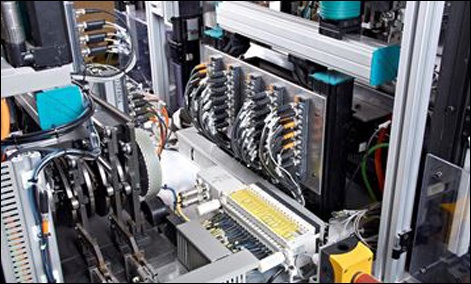3 Steps to Selecting M8 and M12 Cord Sets
Thirty years ago most industrial control systems (ICS) were hardwired. Often sensors and actuators came with long wires already attached or individual wires that weren’t even jacketed together. Those wires would be threaded through conduits and then wired into the system. This was a time-consuming process that required the services of an electrician, costing organizations significant time and money.
The Hannover Fair of 1985 changed all that. M12 connectors were introduced and they stole the spotlight. Incorporating the use of the smaller M12 metric thread, they were initially released in 3-and 4-pin versions, with an IP67 rating. The M8 hit the market four years later, and soon both formats were standardized under IEC 61076-2-101, making them the standard for ICS.
A system that is linked up with M12 and M8 connectors makes assembling, testing and servicing ICS faster and less expensive. These advantages are further enhanced when a cord set is used instead of installing separate cables and connectors. Let’s take a close look at the advantages of M8 and M12 cord sets and the steps needed to select the right one.

M8 cord sets facilitate fast machine start-up time and easy maintenance.
Save Time and Money During Installation and Maintenance
While the upfront investment of cord sets and connectors is greater than cables and wires, the cost savings comes from a reduction in labor and maintenance costs. A large system that might take a week to hardwire could be wired with connectors in as little as two days.
The savings resulting from reduced installation time is significant. Eliminating the need for an electrician further justifies the higher price point for M8 and M12 connectors.
There is another advantage that you may not have thought of. Machine testing and start-up is faster. A lot of time spent during start-up is the result of miswired devices. Prewired and tested cord sets eliminate the majority of wiring errors.
Additional cost reductions come from reduced downtime, as cord sets can easily be replaced, again without need of an electrician. Connectorized sensors and actuators can also be replaced without rewiring the system.
How to choose the right cord set?
1. Start with the Environmental Needs
The possible combinations of cables and connectors is a surprisingly high number. Where do you even start the specification process?
Like most engineering decisions, there’s a balance between cost and performance. You want to choose the lowest cost option that meets the requirements of the application. For example, you don’t need armored cable if it is going to be run in wire trays in a temperature- and humidity-controlled environment.
Thus the first question to ask yourself is “How harsh is the environment for my project?” The answer to this leads to selecting the right industrial cable jacket and the right IP rating for the cord set. Below is a handy table that breaks down the options according to the harshness of the operational setting.
|
Harsh |
Harsher |
Harshest |
|
|---|---|---|---|
|
Description |
The environment is generally contained but is an industrial setting. |
The environment may include exposure to outside elements, some harsh chemicals or weird splatter. |
The environment is exposed to very harsh conditions or involves wash-down or splash conditions. |
|
Application Examples |
General industrial control systems and material handling applications.
|
Automotive plants, farm machinery, petrochemical processing
|
Food and beverage, chemical or pharmaceutical manufacturing, offshore drilling or processing
|
|
Suitable Cable Jackets |
PVC Thermoplastic (TP) Jackets:
|
PUR (polyurethane) Jackets:
TPE(TP) Jackets:*
Tray-Rated Cables (TPE)*
*Note: Both are usually required for the automotive market |
Shielding:
Wash-down Cord Sets:
|
|
Cord Set IP Rating |
IP65, IP67 |
IP65, IP67 |
IP65, IP67, IP68, IP69K |
|
Certifications |
Check if industry specific certifications are required |
||
Table 1: Select a cord set based on harshness of the application’s environment.
2. Determine the Connector Configurations
Since the introduction of the 3- and 4-pin versions of the M12 connector, many more variations and options have become available. While 4-pin M12 connectors are the most common, be sure to analyze your application and choose from:
- straight or right angle configurations
- 3-, 4-, 5-, 8- and 12-pin versions
For M8 connectors your options are:
- Straight or right angle configurations
- Snap(IP65) or screw connection (IP67)
- 3-, 4- and 8-pin versions
3. Select the Keying Options
The M12 connector is also available in a variety of keying/coding options to further minimize wiring errors as follows:
- A-code – Primarily used with sensors and actuators
- B-code – PROFIBUS fieldbus connections
- C-code (dual keyway) – Primarily used with AC sensors and actuators
- D-code – 100Mb EtherNet/IP 4-pin
- X-code – Gigabit Ethernet 8-pin
The following M8 connector configurations feature a keying/coding*:
- B-code – PROFIBUS fieldbus connections
- 8-pin version
Improve Reliability with the Right M8 or M12 Cord Set
The right cord set reduces installation time, wiring errors and machine start-up time.
To select the best value cord set, carefully identify the harshness of the environment. Then select the appropriate cable shielding and cord set that will do the job. There is no point in paying for a wash-down cord set for a material handling application.
Next specify the connector configuration(s) and, in the case of the M12 connector, the keying option(s).
Once production begins, if a sensor or actuator needs to be replaced it can be done quickly, minimizing expensive downtime. Your operation will benefit from maximum dependability and performance.
*The M8 keying option information was updated on April 24, 2015.
